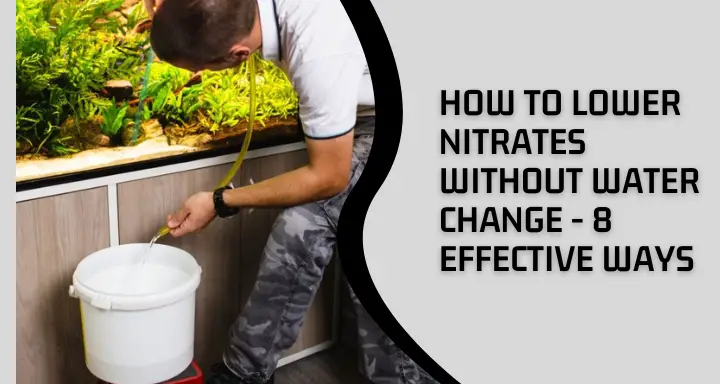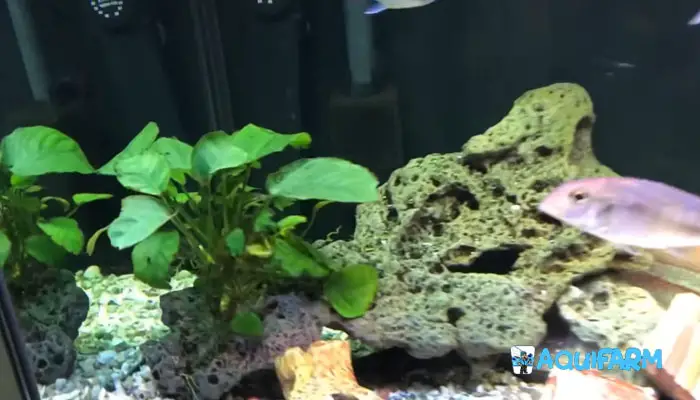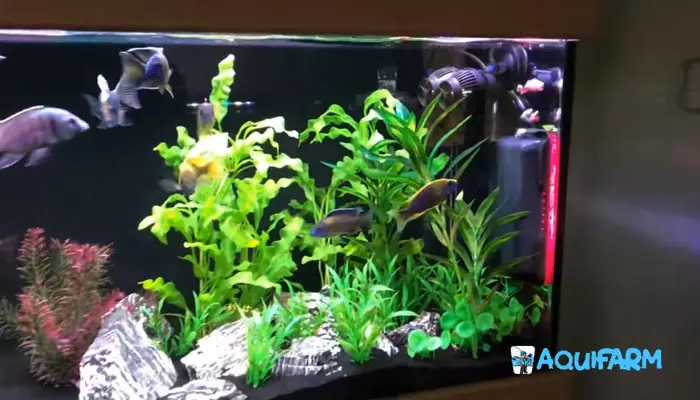
Having higher nitrate levels is problematic for aquariums and fish tanks. Those of us who have aquariums, all know this fact. But, unfortunately, many people can’t try effective ways to solve the problem.
I also didn’t know all the mechanisms properly. But when I faced such a problem, I consulted with my friends. They suggested several ideas. Again, I also researched the internet sections. Thus, I found productive ways to solve my problem.
Then, I thought, I should also share these with my website so that others can find the diversified ways in a single platform. Though the water-changing process can lower nitrates quickly, I can suggest some ways to lower nitrates without water change that I use in the case of my aquarium regularly. So here are those ways described.
8 Ways That Can Lower Nitrates Without Water Change
1. Natural Process
At the top of the list, I will suggest how to lower nitrates in fish tanks naturally. There are several processes that I used to apply in my aquarium to lower the nitrate level. Among them, distillation is the most preferable process for me. Let’s see how I do that.
In this case, you have to add a little amount of baking soda and water conditioner to the aquarium water. Thus, you can lower nitrates without water change in your aquarium.
2. Using Bio-media
Else, you can also lower nitrates by using microbes. Anaerobic bacterias are more effective in this case. You will get several benefits from them.
They can break down and absorb nitrates, they don’t need oxygen as aerobic bacteria, and also don’t produce excessive carbon-di-oxide. Hence, they are considered better than aerobics bacteria in this case.
You can adjust aerobic bacteria flora in your aquarium and thus they will be established in your tank and reduce the nitrate percentage in the water without changing it.
3. Reducing the Fish Population
Another solution can be reducing the fish population. The larger amount of fish will produce a huge excreta. Such types of wastage will enhance the nitrogen level. That’s why you should keep your fish population moderate in the water tank or aquarium.
4. Plants That Reduce Nitrates

Again, you can think of some aquatic plants that can also serve you as the previous options in lowering nitrates in your aquarium. As suggested by the hygger website, some floating aquatic plants like hornwort, spangles, amazon frogbit, and water sprite can absorb nutrients.
According to plant science, such plants need nitrates for their growth and development. Consequently, when you nurture them in your aquarium, they absorb those nutrients and lower the nitrate level in the aquarium.
5. A Refugium

Here I will introduce you to a new technology to lower nitrates in the aquarium. A refugium is an extra space in the aquarium where the algae are produced separately. Microalgae can reduce combined nitrogen compounds, ammonia, nitrate, and nitrite.
That’s why whenever water passes through the algae, the excess nitrates are absorbed by the algae and get purified. But, you have to clean that zone regularly.
Otherwise, the algae production will be higher. Again, some toxic algae also may be produced which will increase the nitrate level instead of reducing it.
6. Reducing Fish Food
As one of the main causes of nitrate increase is fish food, you can lower the amount of food to check the nitrate level. You may also reduce the number of fish so that reduced food cannot be a problem for the plant.
Else, you can transfer your fish to a comparatively bigger tank where the nitrate level will be adjusted with the amount of water. Also, increasing the flow of water in the aquarium can help break down waste and improve filtration.
7. Using a Nitrate Remover
If you are thinking of a nitrogen remover, I will suggest the “Algone”. It will benefit your aquarium water much by not only reducing nitrogen but also clearing the cloudy water produced by nitrates.
Algone is a naturally occurring enzyme or tannin that is made of barley straw. Using this will make your nitrate level perfect for the plant. Also, some nitrate-removing products that can help you to keep your aquarium fresh include nitrate-removing resins, nitrate-reducing bacteria, and protein skimmers.
8. Chemicals To Reduce Nitrates in Aquarium
Finally, you can look for some chemicals to reduce nitrates in aquariums if the other options fail to help you. Varieties of nitrogen-removing chemicals are available in the market that you can use for this purpose.
To help you more in this perspective, I want to suggest a video. You can check it to learn more effectively how to lower nitrates in aquariums.
What Causes High Nitrates in Fish Tanks
Overfeeding
If I want to list down the causes of high nitrates in aquariums or fish tanks, the first cause will be overfeeding. Feeding your fish too much can lead to the creation of excess waste and uneaten food. These residues will break down and release nitrates into the water.
Inadequate filtration
Next, let’s be clear about the filtration mechanism. If your tank’s filter is not powerful enough or is not cleaned regularly, it may not be able to keep up with the amount of waste produced by your fish. This phenomenon will lead to a buildup of nitrates.
Rotten Products
Sometimes, the food or other products that you are using in your filters can be rotten by any means. In such events, if you don’t notice them, they will create more nitrates and the level will be increased fast.
Lack of Water Changes
Regular water changes can also be a major cause of nitrate production. Water changing is important for removing accumulated nitrates and other pollutants from the water. If you do not perform this frequently enough, nitrates can build up to harmful levels.
Overstocking
Besides, having too many fish in a tank can contribute to high nitrate levels. As there will be more waste produced by the excess amount of fish, the tank will not be able to handle it.
Poorly Cycled Tank
The nitrogen cycle is the biological process that converts harmful ammonia produced by fish waste to less harmful nitrite and then nitrate. If the tank is not cycled properly or sufficiently, the nitrate levels may become too high.
Signs of High Nitrates in Aquarium
Poor Water Quality
If the nitrate level is increased in your aquarium, it will be visualized by some signs. You may notice abnormalities in watercolor. Water with high nitrates may appear cloudy or have a strong bad odor. Also, it may be discolored with a brown or greenish tint.
Algae Growth
Sometimes you may notice an overgrowth of algae in the aquarium. This is due to high nitrate levels. Such growth can be especially problematic if the algae are toxic or compete with other plants for nutrients.
Fish Health Problems
High nitrate levels not can also be expressed in the fish’s health. As such types of nitrates can cause stress in fish, the fishes face lethargy, loss of appetite, and respiratory problems.
Importance of Removing Nitrates From Aquarium
As you know, excessive nitrate levels can lead to algae growth and harm the fish and other inhabitants of the aquarium. High levels of nitrates can have negative effects on the aquarium’s inhabitants, such as stunted growth, reduced reproduction, and weakened immune systems.
Besides, it can also lead to the growth of undesirable algae and other unwanted organisms. Therefore, it is essential to monitor the nitrate levels regularly and take appropriate steps to keep them in the safe range.
Perfect Nitrates Level in Freshwater Aquarium
Scientifically, nitrate is a byproduct of the nitrogen cycle in an aquarium, which is necessary for the health of the fish and other aquatic organisms. But there is a recommended amount of nitrates in every aquarium or fish tank according to their parameters.
In a freshwater aquarium, the ideal nitrate level should be below 20 parts per million (ppm). To keep your aquarium environment healthy, you should regularly check this nitrate level. If you find the amount higher, you should immediately take action to reduce it.
Perfect Nitrate Level in Saltwater Aquarium
However, the nitrate level will vary from freshwater to saltwater. The measurement range will be lower for saltwater aquariums.
In a saltwater aquarium, nitrates should ideally be kept below 10 parts per million (ppm) to ensure the health of the aquarium inhabitants. However, it is even better to aim for a nitrate level of 5 ppm or lower to maintain optimal water quality. If it increases, you have to take the necessary steps.
Nitrates or Nitrites- Which is More Harmful in Saltwater Aquarium
Both nitrates and nitrites can be harmful to a saltwater aquarium, but nitrites are generally considered to be more toxic than nitrates.
Nitrites are produced by the breakdown of ammonia in the aquarium and are highly toxic to fish, invertebrates, and other aquatic organisms. Nitrites can interfere with the ability of fish to absorb oxygen, leading to suffocation, and can cause damage to the gills and other tissues.
Nitrites can also disrupt the biological filtration system of the aquarium, making it more difficult to maintain a stable and healthy environment. Nitrates, on the other hand, are produced by the breakdown of nitrites and are less toxic than nitrites.
Therefore, it is important to regularly test the water quality of your saltwater aquarium and maintain appropriate levels of both nitrates and nitrites to ensure the health and well-being of your aquatic pets. To have a vast solution to this problem, you can check my website regularly as I will describe this factor later.
How Long Does it Take to Lower Nitrates in an Aquarium?
The length of time it takes to lower nitrates in an aquarium can vary depending on several factors, such as the size of the aquarium, the level of nitrates present, and the effectiveness of the chosen method of nitrate reduction.
If you want to reduce nitrates in an aquarium through regular water changes, it will dilute the concentration of nitrates in the water. In general, it may take several weeks to see a noticeable decrease in nitrate levels through water changes alone.
But according to our topic, if you try to lower nitrates through the use of nitrate-removing media, such as chemical resins or biological filtration systems, these can be effective in reducing nitrate levels more quickly than water changes alone.
But, you have to be careful in monitoring to ensure they are working properly and not causing any negative effects in the aquarium.
FAQs
How do I test for nitrates in my aquarium?
You can test for nitrates using an aquarium test kit which typically includes test strips or liquid reagents that change color to indicate the level of nitrates in the water.
Our Pick:
[amazon box =”B000255NCI”]Can nitrates be harmful to fish and other aquatic life?
High levels of nitrates can be harmful to fish and other aquatic life, causing stress, illness, and even death. In addition, excessive nitrate levels can lead to algae growth and poor water quality.
Can adding more filtration help lower nitrate levels in an aquarium?
Yes, adding more filtration can help lower nitrate levels in an aquarium by increasing the removal of waste and debris.
Final Thoughts
Finally, I have reached the final point of my discussion. To keep your aquarium atmosphere perfect, it is important to regularly test the nitrate levels in your tank and take steps to address any high levels to prevent harm to your fish and other aquatic life.
Hopefully, these methods will help you to reduce nitrates in aquariums fast. If you want to try this, you are welcome to it. After that, you can inform me if the methods were helpful for you or not. Also, if you know of any better process, you can suggest it to me.
- Top 15 Freshwater Aquarium Plant Ideas for a Lush, Green Tank - November 9, 2024
- Top 13 Freshwater Aquarium Layout Ideas for a Beautifully Organized Tank - November 9, 2024
- 14 Stunning Rustic Freshwater Aquarium Ideas for a Tranquil Environment - November 9, 2024
